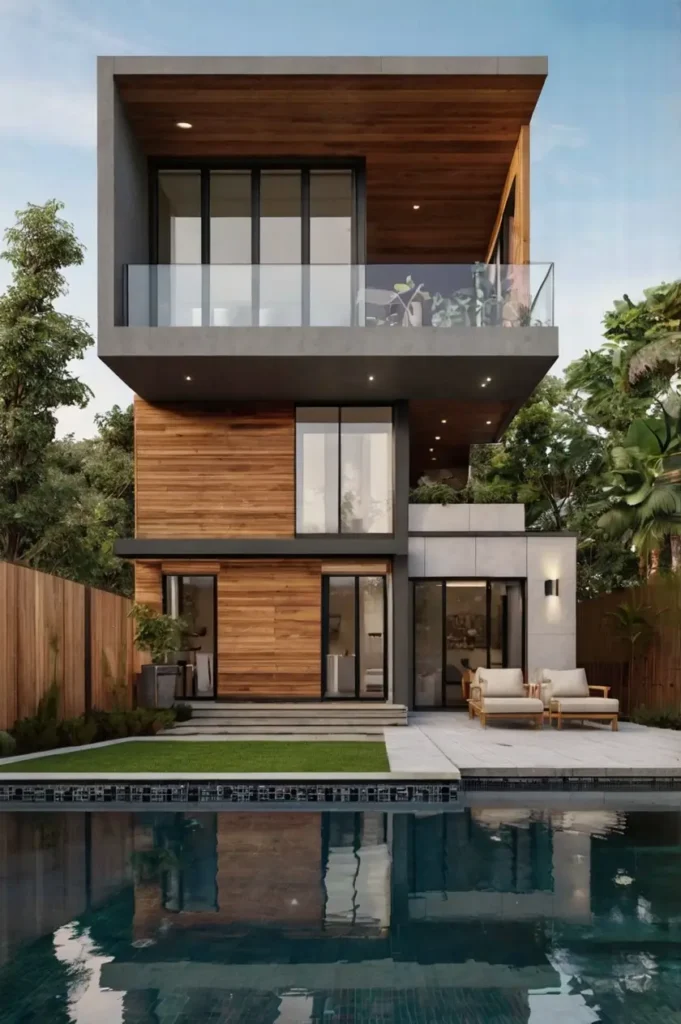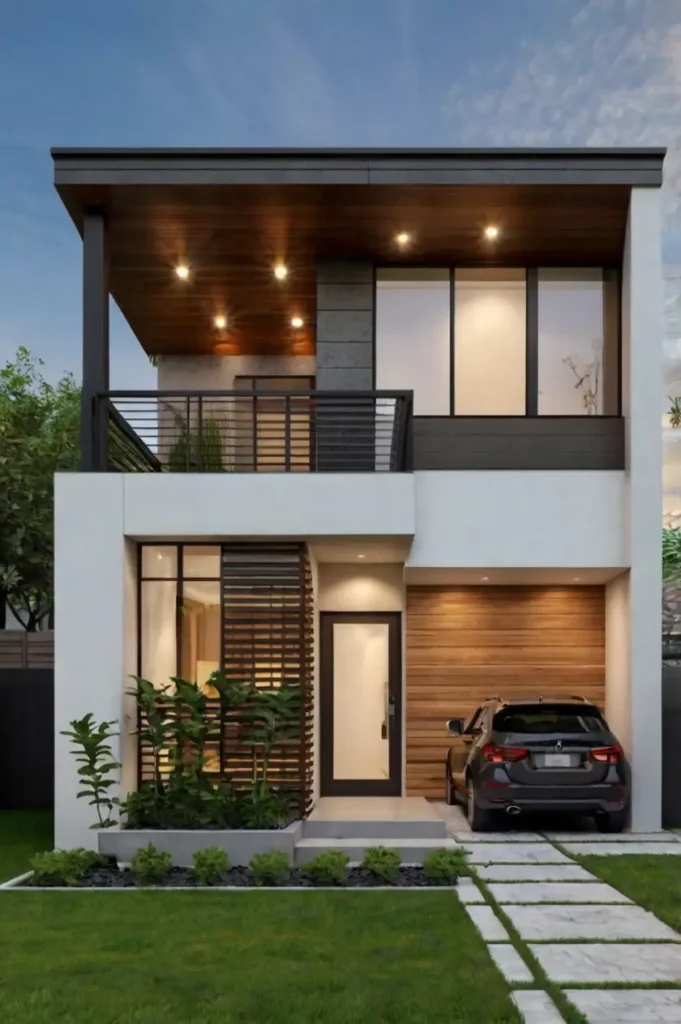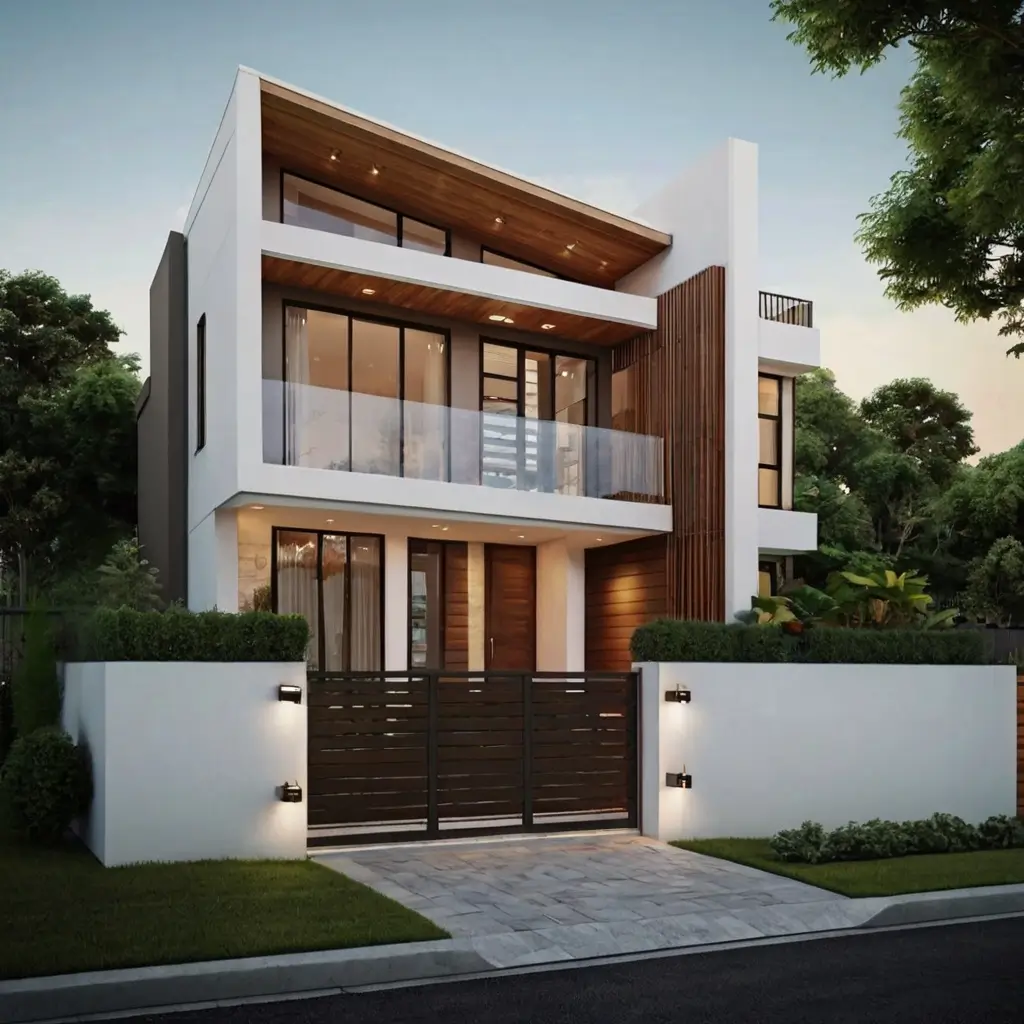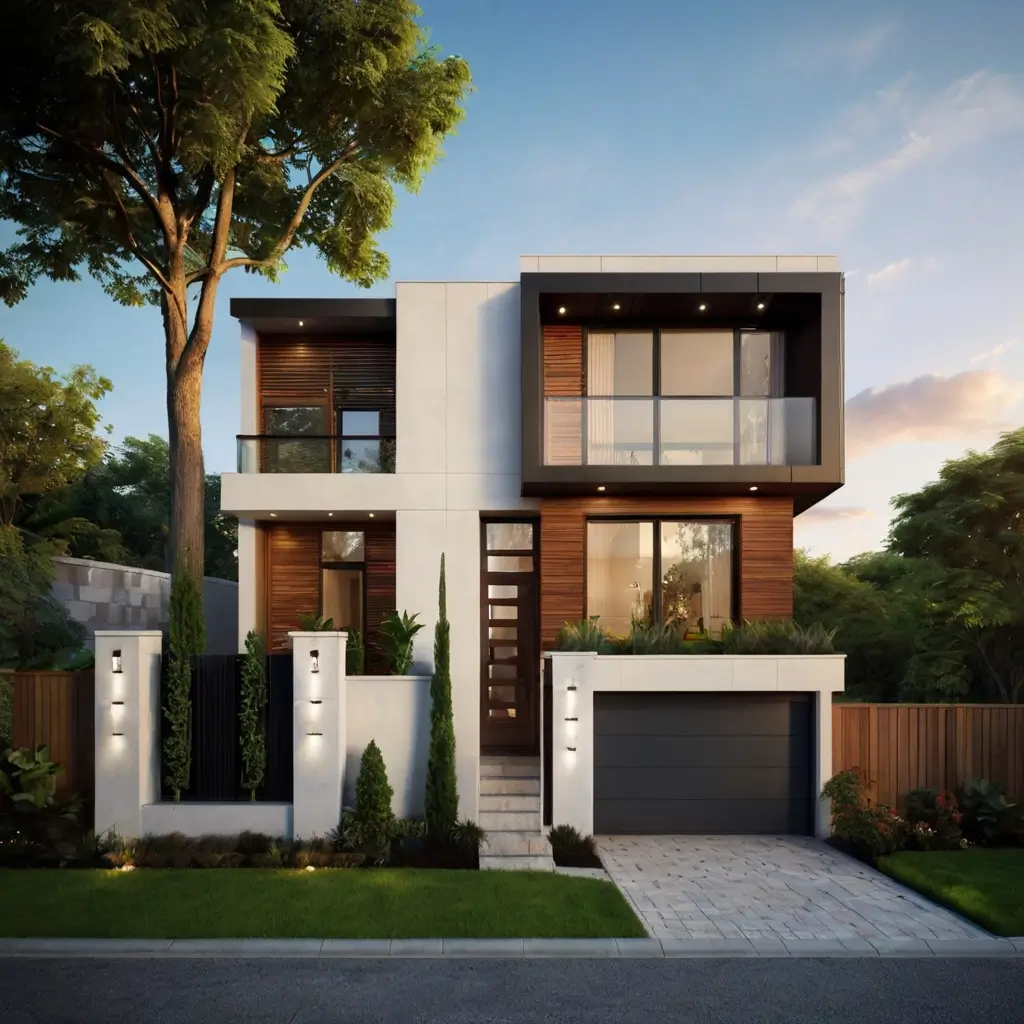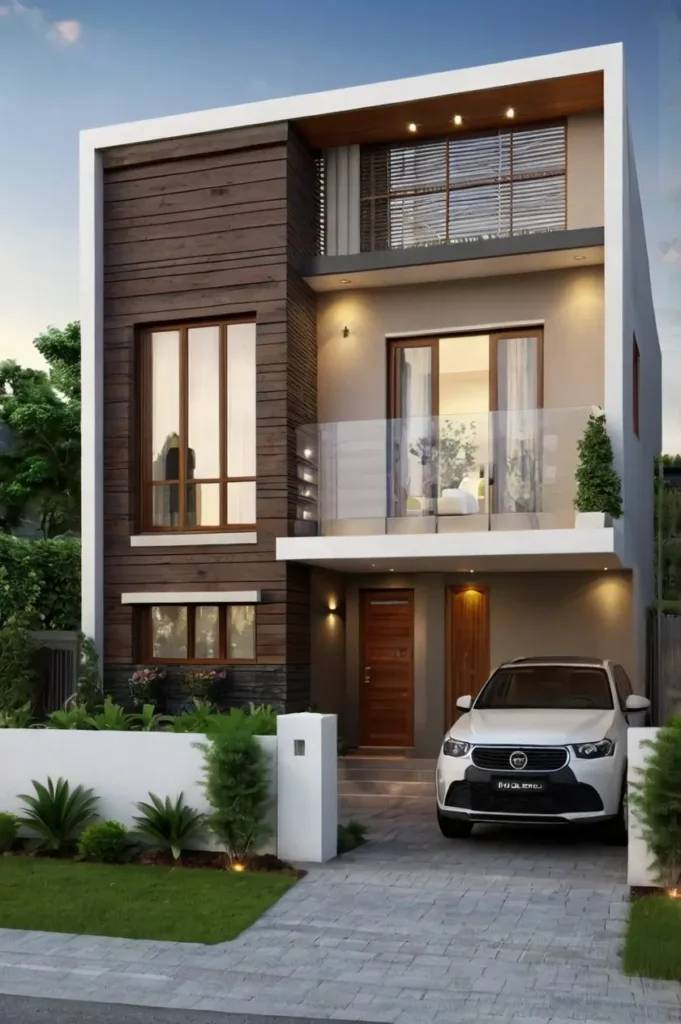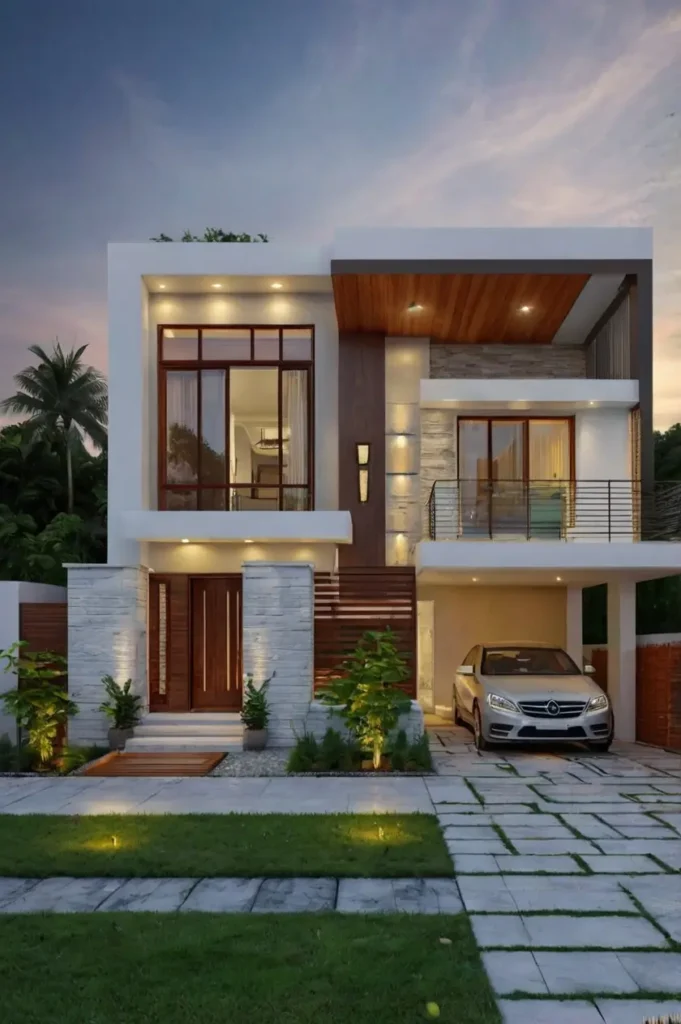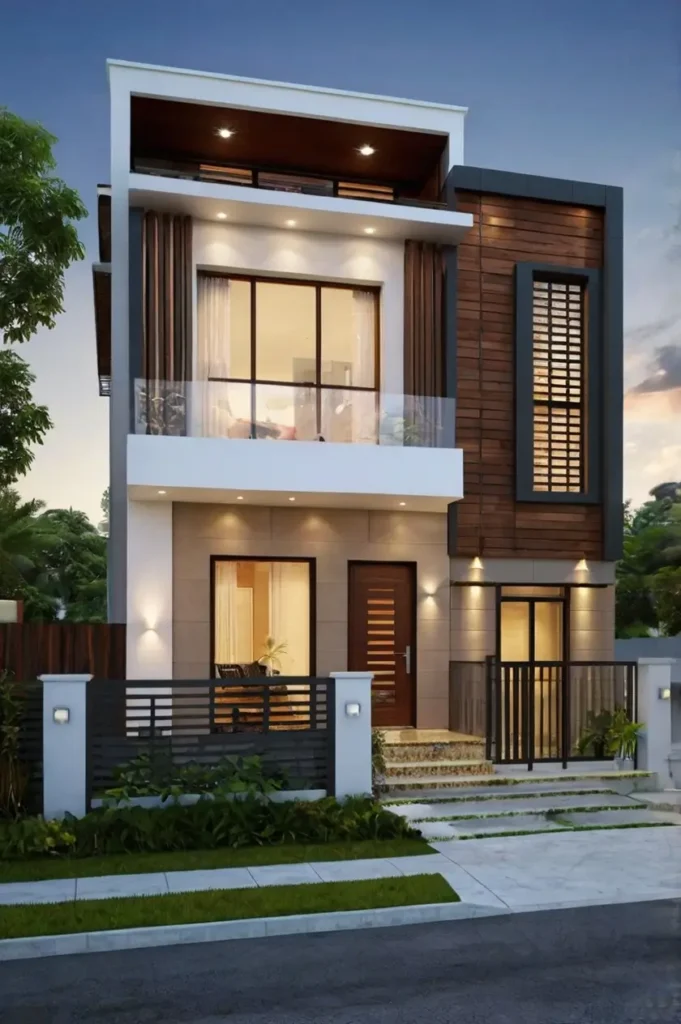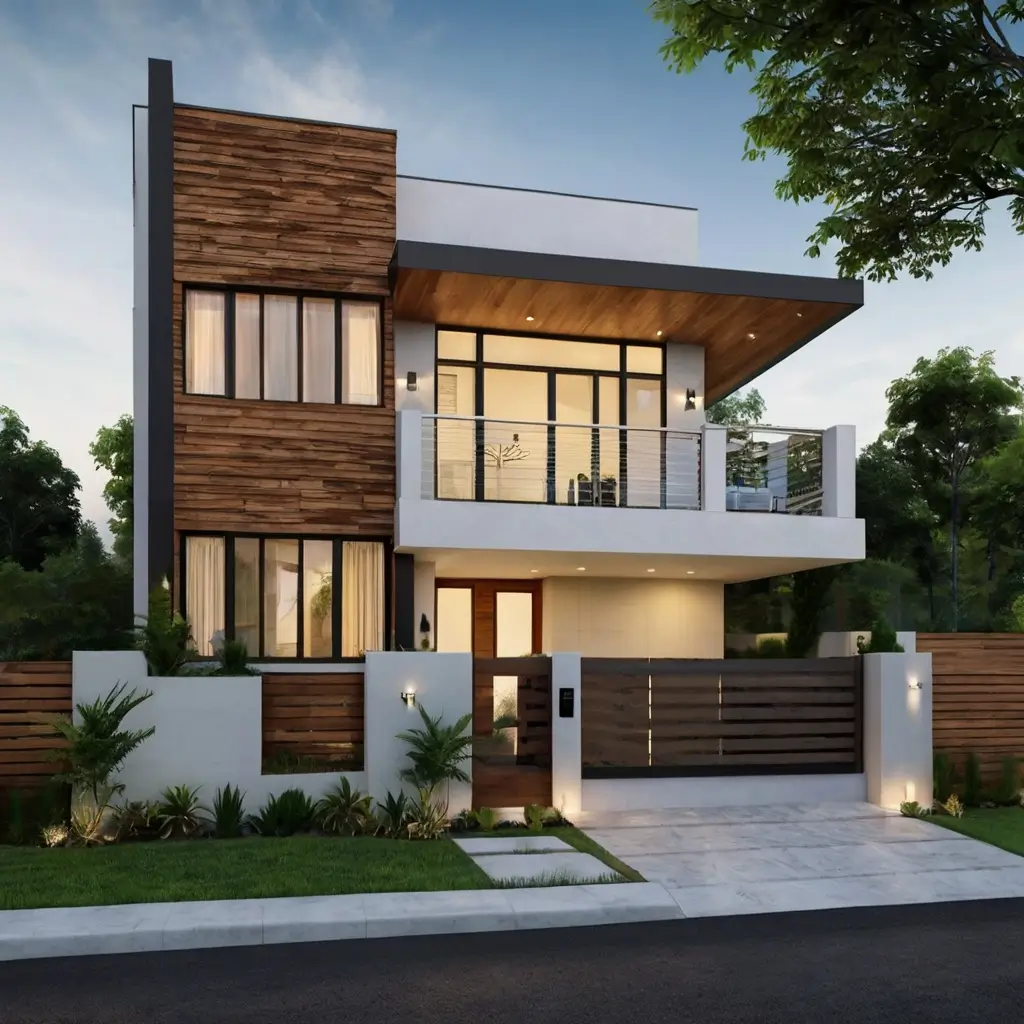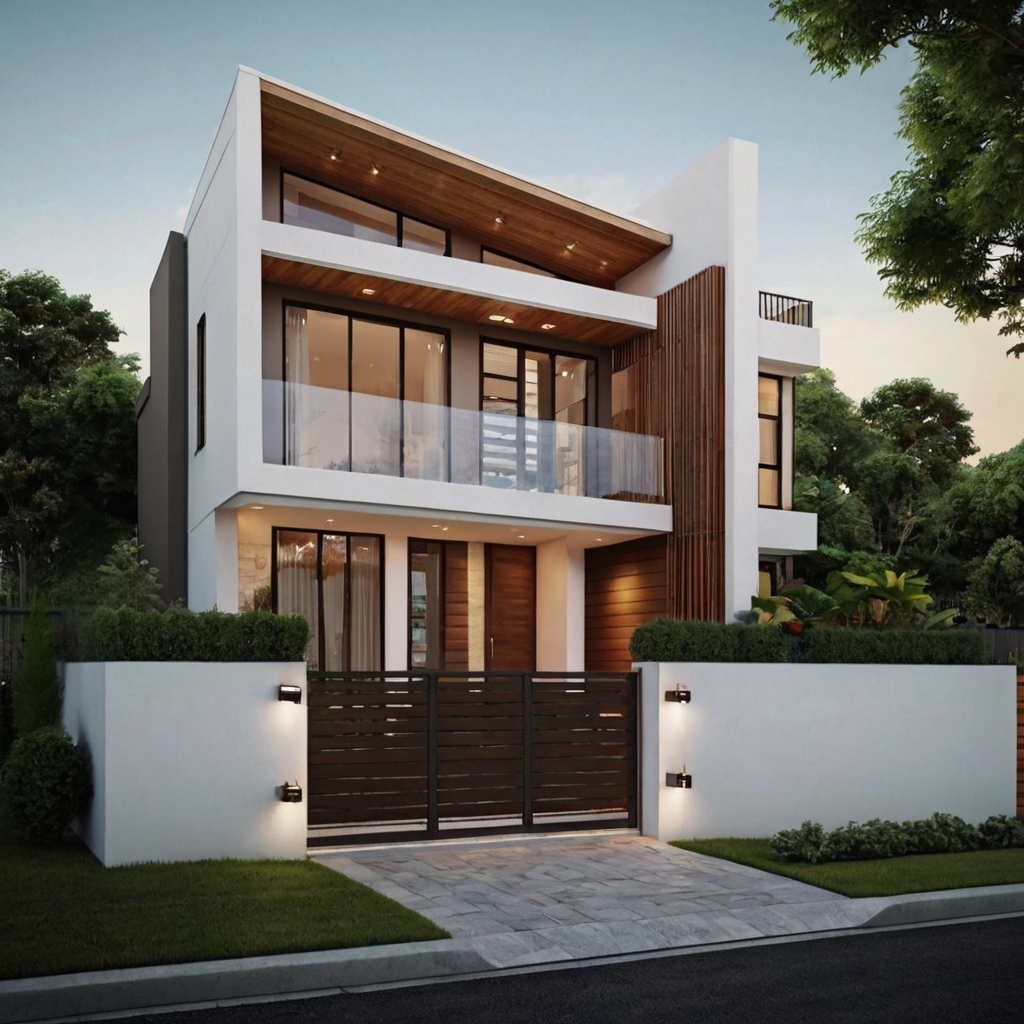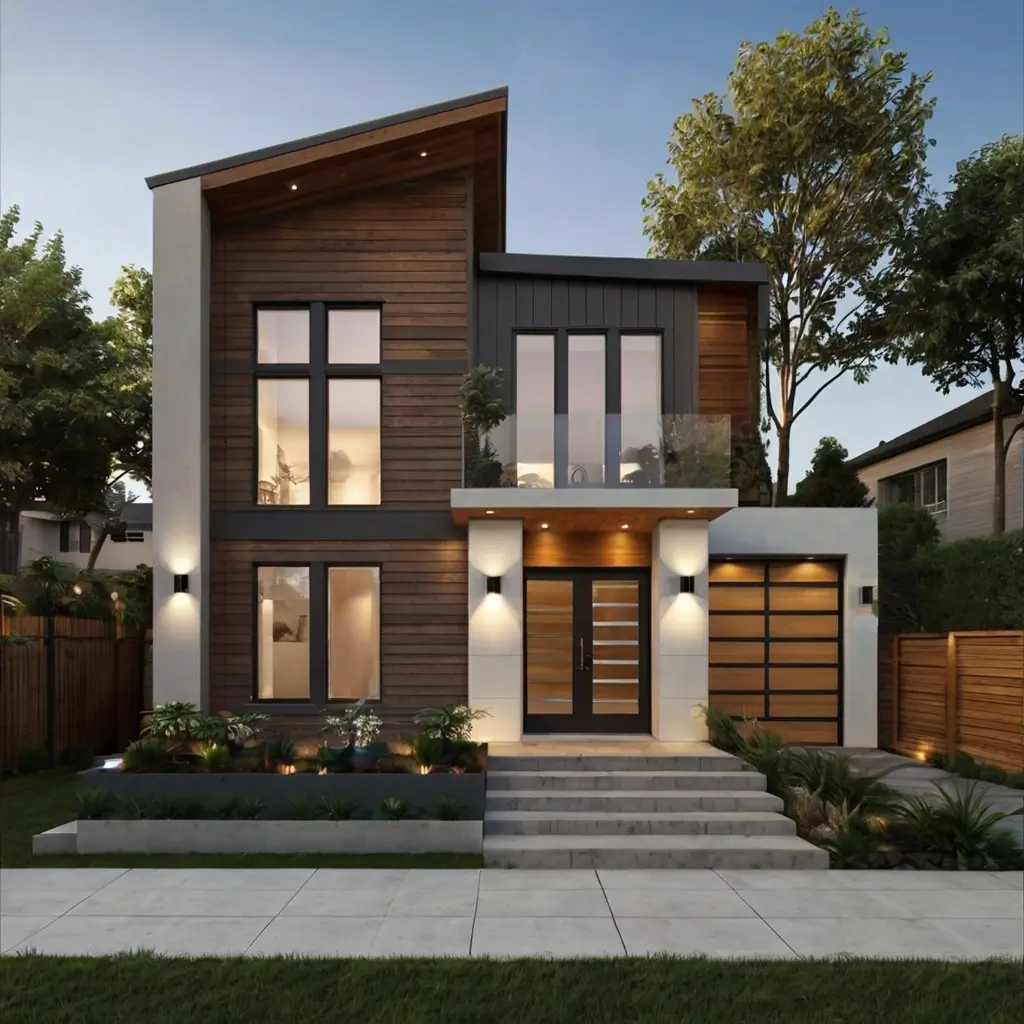When it comes to designing the exterior of a small house, you might think that limited space restricts your creativity. However, with the right approach, you can transform a compact home into a beautiful, functional, and stylish space.
Whether you’re building a tiny house or renovating a small property, these creative exterior design ideas can help you make the most out of your space while leaving a lasting impression.
1. Embrace Minimalism
Important Point
Minimalism is a popular choice for small house exteriors because it simplifies the design while creating a sophisticated and timeless look. By reducing clutter and focusing on essential elements, you make the most of the space available and create a more expansive feeling.
- Color Palette: Stick to a neutral color palette with shades like white, gray, taupe, or beige for the walls. Minimalist designs typically avoid overly bright colors or patterns. Subtle tones allow for a cleaner, more open feel.
- Simple Shapes: The overall structure should feature geometric shapes and clean lines. Avoid overly decorative or complex architectural features. Straight edges and rectangular forms help a small house appear more organized and less cramped.
- Uncluttered Landscaping: Keep the front yard and surrounding area neat and uncluttered. A few well-placed shrubs or small trees with tidy pathways will complement a minimalist exterior.
- Less is More: Stick to essential elements such as a single light fixture, sleek door handles, and unobtrusive windows. Excess details can make a small space feel even smaller, so only add what’s necessary.
2. Use Bold Color Accents
While minimalism thrives on neutrals, adding bold accents can inject personality into a small house’s exterior. Thoughtful use of vibrant colors can create a striking contrast that makes your home stand out.
- Statement Doors: One of the most effective ways to use color is through the front door. A bold-colored door, such as deep red, cobalt blue, mustard yellow, or forest green, can make a strong statement and enhance the character of your small home.
- Window and Trim Accents: Use contrasting colors for window frames, shutters, or trim to highlight the architectural features. Dark frames with light-colored walls create a dramatic look, or you can match the trim with your door color for a cohesive design.
- Roof and Gutter Colors: While roofing often blends with the structure, using a color that contrasts with the walls can add depth. Choose a metal or tile roof in charcoal, dark brown, or even deep green, which can tie the exterior elements together.
- Exterior Features: Other elements such as railings, outdoor furniture, and light fixtures can also be painted in bold shades to coordinate with the overall theme. For example, black or gray railings with a vivid door color can create a modern, stylish exterior.
3. Incorporate Natural Materials
Natural materials are not only beautiful but help connect your small house to its environment, giving it an organic, warm, and timeless appeal. These materials age gracefully and can add texture, dimension, and depth to your exterior.
- Wood: Wood is versatile, offering a range of looks from rustic to modern. Cedar, pine, and redwood are popular choices for cladding because they’re durable and weather-resistant. Use it for siding, accents, or even a feature wall for a natural look that adds warmth and charm. Choose a light finish for a contemporary feel or a darker stain for a more classic, rustic appeal.
- Stone: Incorporating stone or masonry into the exterior design brings texture and a sense of permanence to a small house. Consider a stone foundation or feature wall, or mix stone with other materials like wood or metal. Natural stone like granite, slate, or limestone can also be used for a more modern or rustic aesthetic, depending on the home’s style.
- Metal: Corten steel, galvanized steel, and aluminum can be used as accent materials or for cladding to add a sleek, industrial look. Metal can also be combined with other natural materials, such as wood or stone, to create a balanced, textural exterior.
- Combination of Materials: Don’t hesitate to blend different materials for contrast and visual interest. For example, combine a stone base with wooden upper walls or use metal roofing with wooden accents. This creates layers of texture and can help define your home’s unique character.
4. Open-Concept Porch or Entryway
Creating an open-concept porch or entryway is an excellent way to add outdoor living space while making your small house feel more expansive. This design also increases curb appeal and enhances the first impression of your home.
- Open Porch: Even if your house is small, you can make the porch feel bigger by avoiding walls or enclosing it. Consider using glass railing or low-profile barriers that maintain an open, airy vibe. Incorporating large windows or sliding doors between the porch and interior space further extends the home’s usable area and increases natural light.
- Flooring: The choice of flooring can greatly impact the feel of your porch. Stone, wood decking, or even patterned tiles add interest and help set the tone. Choose light-colored or natural materials for a more expansive feel.
- Furniture: Include simple, comfortable furniture, such as a few chairs, a small bistro table, or a porch swing. These elements invite relaxation and help transition between the outdoors and the home’s interior. Avoid bulky furniture to maintain the sense of openness.
- Landscaping: Keep landscaping simple but effective. Small potted plants, climbing vines, or low shrubs along the railing can add greenery without overcrowding the space. Incorporating planters with flowers or herbs on the porch also adds charm and color.
- Lighting: Install subtle outdoor lighting, such as wall-mounted sconces or string lights, to enhance the porch area in the evening. Lighting creates ambiance and makes the space usable throughout the day.
5. Smart Use of Vertical Space
Maximizing vertical space is crucial for small house exteriors. By thinking upwards, you can create a sense of height and visual interest, making your home feel larger while providing additional functionality.
- Tall Windows: Instead of small, standard windows, opt for taller window installations that stretch from the floor to the ceiling. This will not only let in more light but also visually expand the space. Large windows give the impression of more height, making the house feel less cramped.
- Vertical Gardens: A vertical garden or green wall is a great way to add greenery without using up precious floor space. Using climbing plants like ivy, bougainvillea, or jasmine on trellises along the walls can help create a natural, lush façade. If you prefer a more modern touch, you can install a system of vertical planters or hanging pots along the side of the house.
- Trellises and Pergolas: If you have a small outdoor area, consider installing a trellis or pergola with climbing vines to add vertical greenery. These can serve as attractive focal points, offering shade and a beautiful visual element to the exterior.
- Tall Features: Use vertical architectural elements such as a tall front door, narrow windows, or even a decorative feature like a large, sculptural light fixture to draw the eye upwards. This not only emphasizes the height of the house but also adds a contemporary and stylish touch.
- Rooftop Gardens: If you’re working with a small lot, a rooftop garden can be a fantastic way to make use of vertical space. Planting small trees, shrubs, and flowers on the roof not only enhances the exterior but also adds an outdoor living area to your home.
6. Incorporate Large Windows
Large windows are an excellent way to maximize natural light, create a connection with the outdoors, and give a small house a sense of spaciousness. By incorporating expansive glass panels, you make the interior feel open and airy, even in a compact space.
- Floor-to-Ceiling Windows: These large windows provide uninterrupted views of the outdoors and let in an abundance of light. They are perfect for homes that are located in scenic areas, as they allow you to enjoy your surroundings from within. Choose energy-efficient glass to keep your home insulated while maintaining visibility.
- Sliding Glass Doors: Adding sliding glass doors to the front or back of the house not only enhances the exterior look but also creates seamless transitions between the indoor and outdoor living spaces. Sliding doors open up the entire width of the room, offering an open, inviting feel.
- Bay Windows: A bay window projects outward from the house, offering more interior space and making the exterior look larger. Bay windows are a traditional design element that works well with many styles, especially cottage, Victorian, or modern homes. They can be used in living rooms or bedrooms to create cozy reading nooks.
- Window Walls: If your small house is located in a beautiful setting, a window wall can bring the outdoors in. This consists of multiple windows or a large glass panel that covers one entire wall. It’s especially impactful in areas with breathtaking views, such as mountains, lakes, or forests.
- Architectural Variety: Mix the size and style of windows to add dimension and visual interest. For instance, combine long, horizontal windows in the living room with large, square windows in the kitchen for contrast. You could also frame smaller windows with larger ones for a dynamic look.
7. Go Green with Sustainable Design
Sustainable exterior design elements not only help reduce your environmental footprint but also add charm, value, and efficiency to your small home. Going green in design can lower energy bills, improve comfort, and even increase the home’s longevity.
- Green Roofs: A green roof, also known as a living roof, is covered with vegetation that serves as insulation for the house. This is a great solution for small homes, as it maximizes space and helps reduce the overall energy consumption of the home. Green roofs also provide a stunning aesthetic and can reduce stormwater runoff.
- Solar Panels: Solar panels are an excellent investment for small homes looking to become more energy-efficient. Not only do they help reduce electricity costs, but they also contribute to sustainability. If your roof is flat or has a good southern exposure, installing solar panels can significantly improve energy efficiency.
- Rainwater Harvesting: Installing rainwater harvesting systems is another sustainable design feature that benefits both your home and the environment. By collecting rainwater from your roof, you can use it for irrigation, cleaning, or even household purposes if filtered properly. This reduces water usage and helps manage stormwater runoff.
- Sustainable Building Materials: Choose eco-friendly materials for cladding, flooring, and outdoor elements. Recycled or reclaimed wood, bamboo, cork, and steel are all sustainable choices. Additionally, using locally sourced materials can reduce the carbon footprint of transportation.
- Energy-Efficient Windows and Insulation: Opt for double or triple-glazed windows that provide better insulation, reducing heat loss and increasing energy efficiency. Also, invest in high-quality insulation materials to keep your home comfortable year-round.
8. Innovative Landscaping
Landscaping is an integral part of a small house exterior, as it can enhance the overall aesthetic and help create a seamless connection between your home and the natural environment. With the right landscaping, you can expand the feeling of space, add beauty, and even increase the privacy of your home.
- Vertical Gardens and Planters: Since small yards have limited space, vertical gardens are a great option for bringing greenery to your home. Install wall-mounted planters or garden shelves to create a mini garden without taking up floor space. Climbing plants, such as ivy, can cover walls, fences, or trellises, adding a lush, natural look.
- Low-Maintenance Landscaping: If you’re working with a small space, consider using low-maintenance plants like succulents, native grasses, or drought-tolerant shrubs. These require less water and maintenance while providing texture and visual interest. Native plants are particularly beneficial as they thrive in your local climate, reduce water usage, and attract local wildlife.
- Pathways and Walkways: A well-designed pathway can help make the exterior of your small house feel larger and more cohesive. Use materials like natural stone, gravel, or wood planks for a more organic, rustic feel. Curved walkways also create the illusion of a larger space, as they can guide the eye around the house rather than directly to the front door.
- Green Fencing: If your small house is located in a densely populated area, adding green fencing or privacy screens made from plants can improve privacy and create a calming environment. Use climbing plants or tall hedges to create natural barriers while still allowing for airflow and sunlight.
- Outdoor Living Areas: Add a small patio, deck, or seating area to create an outdoor living space. Keep the furniture minimal but comfortable. A small table with a couple of chairs, or a hammock, can help extend your living area outdoors. This is perfect for small houses with limited interior space.
9. Smart Outdoor Lighting
Outdoor lighting serves both practical and aesthetic purposes for small homes. Thoughtfully placed lighting can highlight architectural features, improve security, and extend the use of your outdoor spaces into the evening.
- Wall-mounted Sconces: Install wall sconces on either side of the entryway to illuminate the front of the house. These fixtures can enhance the entrance while adding a decorative element. Choose fixtures with a modern, sleek look for contemporary designs, or go for more rustic lantern-style lights for traditional exteriors.
- Pathway Lighting: Use low-voltage, solar-powered lights to illuminate pathways, driveways, and garden areas. Path lights not only make the exterior of your home more inviting but also provide safety at night. Position lights along garden edges or walkways for a soft, ambient glow.
- Accent Lighting: Accent lighting can be used to highlight key features of your home, such as a tall tree, a unique architectural element, or a water feature. Spotlights or uplights can create dramatic effects by casting shadows and emphasizing textures in the exterior.
- String Lights: String lights are a popular and easy way to enhance the atmosphere of your small home’s exterior. Drape them along fences, railings, or porch ceilings to create a cozy, magical vibe. These lights can also be used in outdoor dining or seating areas for a warm, festive atmosphere.
- Security Lighting: In addition to decorative lighting, don’t forget about security. Motion-sensor lights near entrances, driveways, or dark corners of your yard can improve safety by illuminating the area when someone approaches.
10. Use of Color and Textural Contrast
Color and texture play a significant role in creating visual interest and depth on a small house exterior. The right combinations of contrasting colors and textures can make your home appear more dynamic and visually appealing.
- Color Blocking: One effective way to create contrast is through color blocking. You can combine two or more contrasting colors in different sections of the exterior, such as the walls and trim, or accent areas like the front door, window frames, or garage door. For example, a neutral base color (such as white or gray) with bold, contrasting accents (like black or navy) can give a modern and clean look.
- Textural Contrast: Mixing different textures can add richness to the design of a small house. Combine smooth, modern materials like stucco or concrete with rougher, natural materials such as wood or stone. For example, a wooden feature wall paired with a metal roof or stone cladding can create a striking contrast.
- Accent Walls: An accent wall with a contrasting color or material can add depth and interest to the exterior. For example, a dark brick feature wall or a contrasting-colored painted section near the entryway can draw the eye and break up the monotony of a single color.
- Metal and Wood: Combining the sleekness of metal with the warmth of wood is a trendy way to add texture and contrast. For example, a wooden deck or siding combined with a metal accent (such as steel framing or galvanized panels) creates a balance of rustic and industrial style that works beautifully for modern small homes.
Conclusion
Designing the exterior of a small house doesn’t have to be limiting. With the right design elements, your small home can be just as stylish, functional, and visually stunning as larger properties.
Whether you prefer minimalist lines, bold accents, or a more natural, rustic look, there are countless ways to enhance your small house exterior.
By maximizing vertical space, using natural materials, incorporating smart landscaping, and focusing on sustainability, you can create a welcoming, modern, and efficient living space that will make a lasting impression.
Like this post? Share it with your friends!
Suggested Read –


